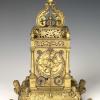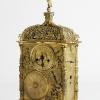Nova reperta: the mechanical clock
Commentary
PRESCRIBED SOURCE
(This source reproduces commentary from the Nova reperta)
Plate 5: Iron Clocks
Caption: ‘Rota aequa ferrea aetherisque voluitur, Recludit aequè et haec et illa tempora.’ ‘The wheel turns, alike of iron and aether; and likewise tells the time, in the sky and on the earth.’
Commentary
The clock and the cosmos. In classical cosmology, ‘aether’ is the ‘quintessence’: the material of which the heavens are composed, the ‘fifth essence’ in addition to the four elements of earth, water, air, and fire which make up the terrestrial realm. By extension, ‘aether’ can refer to the celestial region itself.
In the caption, the ‘wheel of aether’ which tells the time in the heavens is therefore the uniform circular motion of the heavenly bodies themselves. In traditional Ptolemaic-Aristotelian cosmology as further developed during the Middle Ages, the planets and stars are moved by a complicated system of celestial spheres: an armillary sphere is traditionally regarded as a simplified model of parts of that system, while Santucci’s sphere attempted to model it in something more like its full complexity.
The caption identifies the wheels of the clock with those of the heavens. Iron gears, made of one of the heaviest forms of the most earthbound of elements, are not merely compared to but identified with celestial spheres, composed of the lightest, nimblest, most ‘aetherial’ of matter. The clock is therefore both a paradox and a microcosm, a mechanical model of the cosmos in miniature. The objective of the clockmaker is to mimic on the clock face the uniform, circular and perpetual motion of the primum mobile, the outermost celestial sphere.
This equivalence of the clock face and the heavens is made explicit on large, freestanding clock in the centre of this image: its face depicts a heliocentric cosmos, with the earth (represented by the single long hand) orbiting a central, immobile sun. This is an idea developed in innumerable ways by clockmakers from the fifteenth into the seventeenth centuries. The oldest example still in operation is also perhaps the most famous: the astronomical clock in the town square in Prague, which dates from 1410. More modest astronomical and astrolabe table clocks from the seventeenth century can be found in the Museum of the History of Science. The celestial globe clock brought to Prague by Rudolf II in 1584 takes the idea of the clock as model of the celestial sphere to its logical conclusion.
The mechanical clock was not merely a physical model of the cosmos: it also became an intellectual model with which to conceive the motion of the heavenly bodies and the forces moving them. Viewed from this perspective, the mechanical clock is much more than an example of artisanal ingenuity: it represents a major intellectual step on the way to the mechanical conception of the natural world which helped give rise to modern science based on mathematical laws.
Unlike the compass, gunpowder and printing press, the mechanical clock driven by falling weights appears to have been a European invention. When set in a global rather than merely continental context, its origin shortly before 1300 is therefore one of the most significant nova reperta depicted in this series of prints.
Clockmaking. This image attempts to give an impression of the process of manufacture. In the centre, a smith picks heated metal parts from a forge with lengthy forceps and plunges them into a water bath, while another works the bellows. To the left hang moulds containing individual parts cast in metal. On the workbench in the foreground, one man files teeth in a wheel held in a vice, which his senior colleague examines closely through spectacles. In the centre foreground, another artisan is embellishing the case of a large, free-standing clock. To either side hang wall clocks driven by long weights, the predecessors of the pendulum clocks invented later in the century. The extremely sketchy depiction of the production process implicitly reveals a basic fact: clock making remained a complex, artisanal process, nothing like the mass production of printed pages and engravings.
Credit: Howard Hotson (March 2017)


